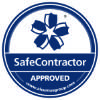Up to: < Surveys
What do the acronyms MA and PA Mean on Asbestos Survey Reports?
Material Assessment and Priority Assessment

Material Assessment
Who completes this and how?
Most surveying organisations use The Health and Safety Executive’s risk assessment process. Detailed within HSG264, it uses a material assessment algorithm to calculate how dangerous a material is. Each material identified, is scored against the four risk factors detailed below. Score ratings range from ‘0’ to ‘3’.
- Friability - this is a term used to describe the crumbliness of a material, which directly corresponds to the likelihood of the material releasing fibres. Materials with high friability, such as insulation, are more likely to release fibres than those with low friability, such as vinyl floor tiles.
- Condition - damaged products are more likely to release fibres than products in good condition. Products are ranked according to the extent of damage observed.
- Surface treatment - this term describes how the materials are protected from fibre release. Materials that are bonded within a strong matrix, such as vinyl floor tiles are the safest. In contrast, materials that are damaged easily and have no protective coating, such as sprayed asbestos and lagging materials, would be assigned a higher score, especially if unsealed.
- Asbestos type - there are six regulated types of asbestos. Including: crocidolite, amosite, actinolite, anthophyllite, tremolite and chrysotile.
Once you have a score for each of the above variables, these are then accumulated to give a risk score between ‘1 ‘and ‘12’.
Material Risk Rating Description
When using this algorithm it is commonly accepted that materials can be categorised into one of the following risk groups:
- Combined score between 10-12 - high risk materials.
- Combined score between 7-9 - medium risk materials.
- Combined score between 5-6 - low risk materials.
- Combined score between 1-4 - very low risk materials.
Priority Assessment
How is this completed?
This involves looking at the risk of someone coming into contact with the asbestos product within your property. It is also broken down into categories. A score between ‘0’ and ‘3’ is assigned to each.
- Scores for disturbance - a ‘0’ score may be given to a room which is never really occupied, if at all. A score of ‘1’ may be assigned to a boiler room that is rarely accessed. Contrastingly, a score of ‘3’ would be assigned to a room with high levels of constant use. An assessment of the accessibility of the product should also me made. The more easily it could be disturbed the higher the score assigned. The extent of the product affects the score too, with asbestos containing materials that span 50sqm or more being assigned the highest score of ‘3’.
- Scores for human exposure - initially this looks at the number of people that are likely to be exposed. If this is considered to be over 10 people, then a score of ‘3’ would apply. Next the frequency that the area is used needs to be assessed, with daily use being assigned a ‘3’.
Sometimes sub-categories are included to take into account the different risk levels subject to the use of a room or specific location. A school hall, for example, may be used as a canteen throughout the day, but used for sports in the evenings. These activities would present different risk levels, so the normal and secondary activity scores would be combined to give you an overall risk rating.
Who completes this?
The duty holder is normally best informed to enable an accurate priority risk assessment to be compiled. It is common for them to have detailed knowledge of the building and its uses. Tacit information which is required to complete this assessment. An asbestos consultancy such as Scientific Services can assist with its completion, but input from a site manager would be required.



